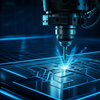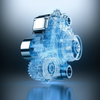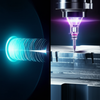
What a Post Processor in CAM Software Actually Does
Unlock CNC machining precision. Learn what a post processor in CAM software is, how it translates toolpaths into machine-specific G-code, and why it's critical.

Machining Delrin vs. Acrylic: An Essential Compariso
Choosing between Delrin and acrylic for your machining project? Discover the key differences in strength, machinability, and applications to select the right material.

Best CAD Software for CNC: A Practical Comparison
Discover the best CAD software for your CNC projects. Compare top options like Fusion 360, Vectric, and SolidWorks to match your budget and skill level.

Mastering CNC Workholding: Secure Parts for Flawless Results
Unlock precision in your machining with a clear guide to CNC workholding. Learn to select the right devices and methods to prevent errors and achieve perfect parts.

Achieve Perfect Setups With a CNC Mill Edge Finder
Unlock machining accuracy with the right edge finder for your CNC mill. Learn the types, how to use them, and select the best tool for perfect setups every time.

Essential Tool Length Offset Basics for Accurate CNC Machining
Unlock precision in your CNC work. Learn the fundamentals of tool length offset, from setting values to applying G-code, and avoid costly mistakes.

Rapid Tooling Services: Your Bridge to Market Production
Discover how rapid tooling services accelerate product development. Learn about key technologies, cost benefits, and when to use this method for low-volume production.

Unlock Agility With On-Demand Manufacturing Solutions
Explore on-demand manufacturing solutions to reduce costs, accelerate time-to-market, and boost innovation. Learn how technologies like 3D printing transform production.





